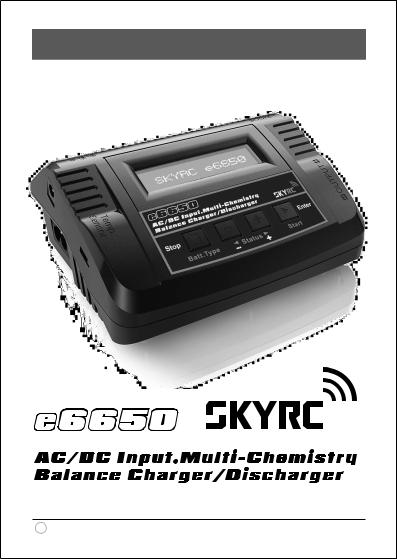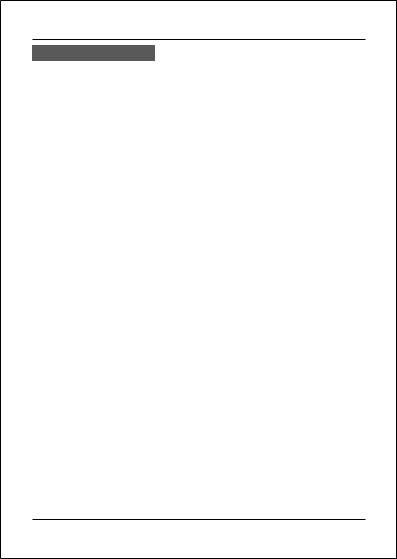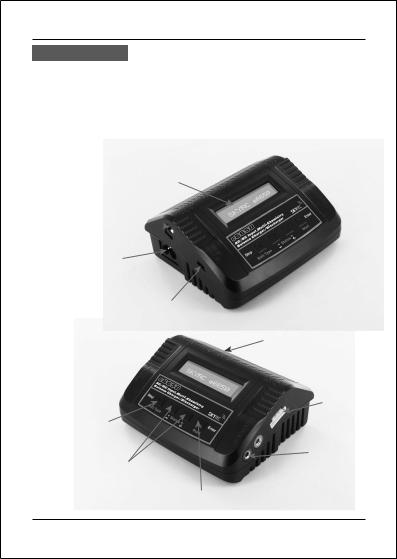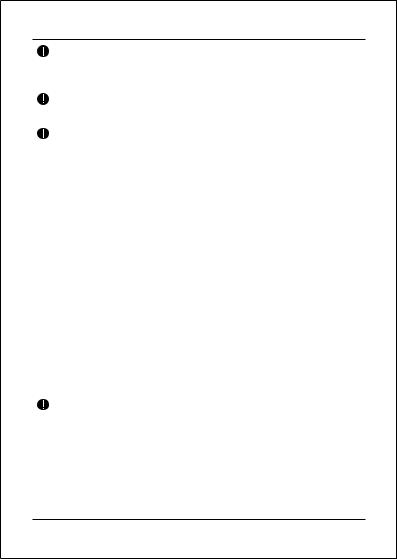SkyRC e6650 User Manual

INSTRUCTION MANUAL |
|
C SkyRC Technology Co., Ltd. 2010 |
Version 1.0 |

TABLE OF CONTENTS
TABLE OF CONTENTS
Introduction |
02 |
|
|
Special Features |
03 |
|
|
Lithium Polymer Balance Charge Program Connection Diagram |
05 |
|
|
Warning and Safety Notes |
06 |
|
|
Program Flow Chart |
11 |
|
|
Initial Parameter Setup (Users Set Up) |
12 |
|
|
Lithium (LiPo/Lilon/LiFe) program |
15 |
|
|
Charging Lithium Battery in Charge Mode |
16 |
|
|
Charging Lithium Battery in Balance Mode |
16 |
|
|
Fast Charging of Lithium Battery |
17 |
|
|
Charging Lithium Battery in the Fast Charge Mode |
17 |
|
|
Storage Control of Lithium Battery |
18 |
|
|
Charging Lithium Battery in the Storage Mode |
18 |
|
|
Discharging of Lithium Battery |
19 |
|
|
Voltage Balancing and Monitoring in the Discharge Process |
19 |
|
|
Charging of NiCd/NiMH Battery |
20 |
|
|
Charging NiCd/NiMH Battery in the Charge Mode |
20 |
|
|
Discharge of NiCd/NiMH Battery |
20 |
|
|
Charge/Discharge and Discharge/Charge Cycle of NiCd/NiMH Battery |
21 |
|
|
Charging of the Pb Battery |
21 |
|
|
Charging Pb (lead-acid) Battery in the Charge Mode |
22 |
|
|
Discharging of the Pb Battery |
22 |
|
|
Data Storage Program |
23 |
|
|
Load Data Program |
24 |
|
|
Various Information in the Program |
25 |
|
|
Warning and Error Message |
26 |
|
|
Specifications |
27 |
|
|
Warranty and Service |
27 |
- 01 -

INTRODUCTION
INTRODUCTION
Thank you for purchasing the e6650 LiPo Balance Charger by SKYRC.This product is a rapid charger with a high performance microprocessor and specialized operating software. Please read this entire operating manual completely and attentively before using this product, as it covers a wide range of information on operating and safety or please do use this product in company with a specialist!
LCD Display (16 chr.* 1 line)
DC Input Power Port
11-18V DC 
AC Input Power Port
(AC 100-240V, 50/60HZ)
Temperature
Sensor Port
Scroll Through
the Main Menu
Stop any Charge Processes
Alter Values Cells
in Balance Charge Mode See the Status of Individual
Temperature
Controlled Fan
Balance
Socket
 Output
Output
Charging
Resume or Start Charge Processes
Confirm an Action
- 02 -

SPECIAL FEATURES
SPECIAL FEATURES
Optimized operating software
e6650 features the so-called AUTO function that set the feeding current during the process of charging or discharging. Especially for Lithium batteries, it can prevent the overcharging which may lead to an explosion due to the user's fault. It can disconnect the circuit automatically and alarm once detecting any malfunction.
All the programs of this product were controlled through two way linkage and communication, to achieve the maximum safety and minimize the trouble. All the settings can be configured by users!
Internal independent lithium battery balancer
e6650 employs an individual-cell-voltage balancer. It isn’t necessary to connect an external balancer for balance charging.
Balancing individual cells battery discharging
During the process of discharging, e6650 can monitor and balance each cell of the battery individually. Error message will be indicated and the process will be ended automatically if the voltage of any single one cell is abnormal.
Adaptable to various type of lithium battery
e6650 is adaptable to various types of Lithium batteries, such as Li-ion, LiPo and the new LiFe series of batteries.
Fast and storage mode of lithium battery
Purposes to charge Lithium battery varies, ‘fast’ charge reduce the duration of charging, whereas ‘store’ state can control the final voltage of your battery, so as to store for a long time and protect useful time of the battery.
Maximum safety
Delta-peak sensitivity: The automatic charge termination program based on the principle of the Delta-peak voltage detection. When the battery's voltage exceeds the threshold, the process will be terminated automatically.
- 03 -

SPECIAL FEATURES
Automatic charging current limit
You can set up the upper limit of the charging current when charging your NiCd or NiMH battery; it is useful for the NiMH battery of low impedance and capacity in the 'AUTO' charging mode.
Capacity limit
The charging capacity is always calculated as the charging current multiplied by time. If the charging capacity exceeds the limit, the process will be terminated automatically when you set the maximum value.
Temperature threshold*
The battery’s internal chemical reaction will cause the temperature of the battery to rise. If the temperature limit is reached, the process will be terminated.
* This function is available by connecting optional temperature probe, which is not included in our package.
Processing time limit:
You can also limit the maximum process time to avoid any possible defect.
Input power monitoring
To protect the car battery used as DC input power from being damaged, its voltage keeps being monitored. If it drops below the lower limit, the process will be ended automatically.
Data store/load
The maximum five batteries’ data can be stored for users’ convenience. You can keep the data pertaining to program setting of the battery of continuous charging or discharging.
Users can call out these data at any time without any special program setting.
Cyclic charging/discharging
1 to 5 cyclic and continuous process of charge>discharge or discharge>charge is operable for battery refreshing and Balancing to stimulate the battery's activity.
- 04 -

LITHIUM POLYMER BALANCE CHARGE PROGRAM CONNECTION DIAGRAM
LITHIUM POLYMER BALANCE CHARGE PROGRAM CONNECTION DIAGRAM
This diagram shows the correct way to connect your battery to the e6650 charger while charging in the balance charge program mode only.
 WARNING:
WARNING:
Failure to connect as shown in this diagram will damage this charger.
The main battery leads must be connected along with the balance lead connector as shown before charging your battery .
- 05 -

WARNING AND SAFETY NOTES
WARNING AND SAFETY NOTES
These warnings and safety notes are particularly important. Please follow the instructions for maximum safety; otherwise the charger and the battery can be damaged or at worst it can cause a fire.
Never leave the charger unattended when it is connected to its power supply. If any malfunction is found, Terminate THE PROCESS AT ONCE and refer to the operation manual.
Keep the charger well away from dust, damp, rain, heat, direct sunshine and vibration. Never drop it.
 The allowable input voltage is 11-18V DC/110-240V AC.
The allowable input voltage is 11-18V DC/110-240V AC.
This charger and the battery should be put on a heat-resistant, noninflammable and nonconductive surface. Never place them on a car seat, carpet or similar. Keep all the inflammable volatile materials away from operating area.
Make sure you know the specifications of the battery to be charged or discharged to ensure it meets the requirements of this charger. If the program is set up incorrectly, the battery and charger may be damaged .It can cause fire or explosion due to overcharging. This warranty is not valid for any damage or subsequent damage arising as a result of a misuse or failure to observe the procedures outlined in this manual.
- 06 -

WARNING AND SAFETY NOTES
NiCd/NiMH
-Voltage level: 1.2V/cell
-Allowable fast charge current: 1C-2C (depends on the performance of cell)
-Discharge voltage cut off level: 0.85V/cell (NiCd), 1.0V/cell(NiMH)
Li-ion
-Voltage level: 3.6V/cell
-Max. charge voltage: 4.1V/cell
-Allowable fast charge current: 1C or less
-Min. discharge voltage cut off level: 2.5V/cell or higher
LiPo
-Voltage level: 3.7V/cell
-Max. charge voltage: 4.2V/cell
-Allowable fast charge current: 1C or less
-Discharge voltage cut off level: 3.0V/cell or higher
LiFe
-Voltage level: 3.3V/cell
-Max. charge voltage: 3.6V/cell
-Allowable fast charge current: 4C or less
-Discharge voltage cut off level: 2.0V/cell or higher
Pb
-Voltage level: 2.0V/cell
-(Lead-acid) Max. charge voltage: 2.46V/cell
-Allowable fast charge current: 0.4C or less
-Discharge voltage cut off level: 1.75V/cell or higher
-07 -

WARNING AND SAFETY NOTES
To avoid short circuit between the charge lead always connect the charge cable to the charger first, then connect the battery. Reverse the sequence when disconnecting.
Do not connect more than one battery pack to this charger at any one time.
Never attempt to charge or discharge the following types of batteries.
A battery pack which consists of different types of cells (including different manufacturers)
A battery that is already fully charged or just slightly discharged. Non-rechargeable batteries (Explosion hazard).
Batteries that require a different charge technique from NiCd, NiMh, LiPo or Gel cell (Pb, Lead acid).
A faulty or damaged battery.
A battery fitted with an integral charge circuit or a protection circuit.
Batteries installed in a device or which are electrically linked to other components.
Batteries that are not expressly stated by the manufacturer to be suitable for the currents the charger carries during the charge process.
Please bear in mind the following points before commencing charging.
Did you select the appropriate program suitable for the type of battery you are charging?
Did you set up adequate current for charging or discharging?
Have you checked the battery voltage? Lithium battery packs can be wired in parallel and in series, i.e. a 2 cell pack can be 3.7V (in parallel) or 7.4V (in series).
- 08 -
